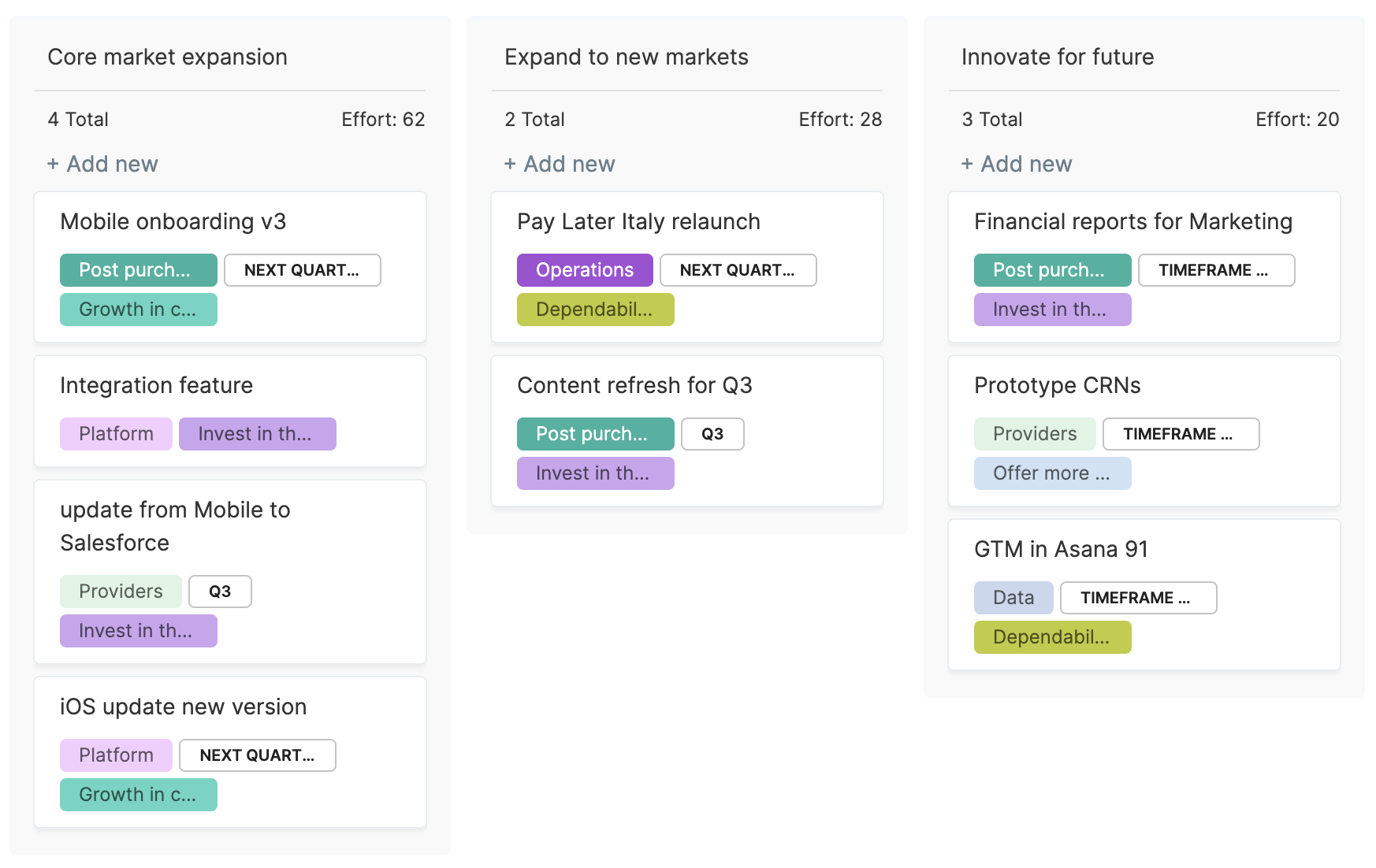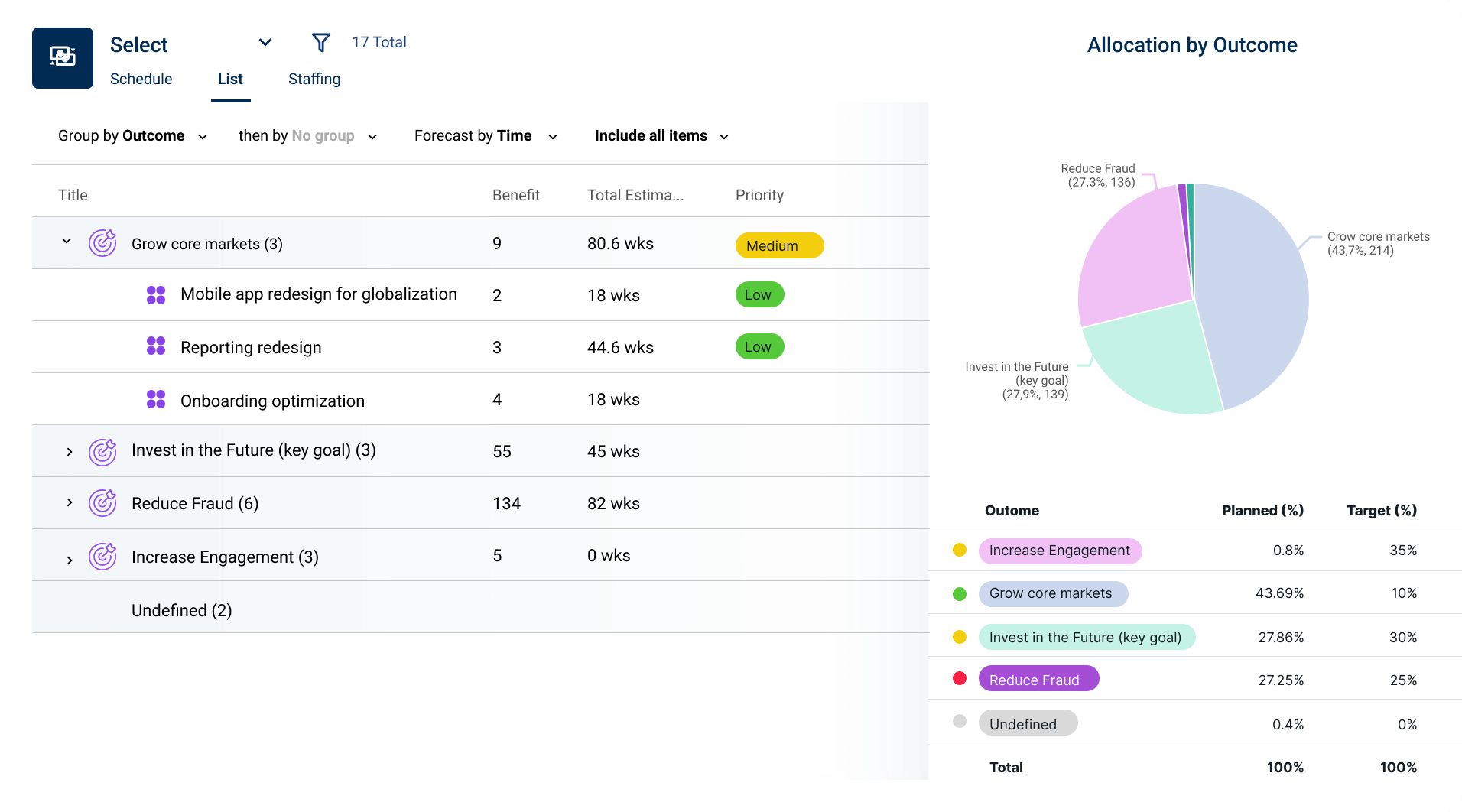There are many types of product roadmaps – each is designed to communicate the right information to the right audience. Often product teams focus on creating product roadmaps that communicate “what” they are working on, but the context, or the “why”, is often missing. The last thing team members want is for an executive or stakeholder to look at the roadmap and ask, “Why are we working on that?” So, in this post, we will delve into the question of “What is an effective product roadmap and how to create one?”
What is An Effective Product Roadmap?
A product roadmap is a visual representation of your product strategy with one primary purpose – facilitating communication with various stakeholders. As such, it must include three fundamental elements:
- What: The bets, initiatives, and ideas.
- Why: The goals, strategy, value, customers, and other must-haves.
- When: Some time element.
As mentioned above, however, it is in the middle where product teams falter. Most roadmaps communicate what and when but don’t explain why we are working on this instead of that. Product roadmaps naturally evolve with your company and products to include details like security needs, dependencies, and resource allocation. But this entire exercise is pointless without the north star of “why.”
Sometimes, it helps to remind yourself why product roadmaps matter in the first place.
Why Are Effective Product Roadmaps Important to Businesses?
Businesses use product roadmaps for many purposes, from communicating strategic plans to the board, executives, and key customers to managing day-to-day product development activities. And, indeed, that may be part of the issue. Product managers must constantly adjust their roadmaps to address different audiences and accommodate change, which makes it easy to lose sight of the big picture.
However, it is vital to remember that the entire reason for creating a roadmap is to keep your product initiatives in sync with your product vision while supporting the company’s short-term and long-term business goals. After all, we don’t create a product for no reason; we build a product to deliver value to our customers and shareholders.
3 Templates of Effective Product Roadmaps
Of course, the exact type of product roadmap that is right for you depends on your organization and who will use it. To show you what we mean, let’s look at three examples where we helped our customers design roadmaps to answer the “why.”
Strategic Focused Area (aka Theme based) Roadmap
One company we work with uses the term strategic focus areas to describe and communicate the high-level strategy for the business. In a recent year, this company had three strategic focus areas:
- Grow
- Protect
- Drive efficiencies
They had a beautiful slide describing each strategic theme (I wish I could share a screenshot). The Chief Product Officer (CPO) showed it off in meetings, inspiring her teams to plan and execute against the SFAs.
The idea, of course, was that each product team would use these SFAs to create their product roadmaps. But what actually happened is that they created roadmaps describing what they would work on and when they would deliver. No one could show the work in the context of the SFAs.
They needed a strategic focus area roadmap. So that’s what we helped them create – a strategic roadmap that shows:
- Planned product initiatives
- For each strategic focus / theme
- Estimated timeframe
Then, we helped them create different representation of this roadmap.
- One for each product.
- One showing progress against the plan.
- And one that puts them all together in a portfolio.
Everyone, from CPO to business stakeholders, can now see real-time progress without the distraction of the details and can easily share it with the executive team – linking the team’s work to what is most important to the business.

Outcome-Based Roadmap
We have been working with a brick-and-mortar company that is starting a digital product team. As part of their business case, they want to show that the products they deliver impact the number one priority of the business: managing cost.
In any type of manufacturing business, minimizing and reducing costs is vital. Work that does not focus on this crucial goal or needlessly adds costs is not viable.
This product team wants to build roadmaps based on various cost metrics to show that product initiatives will drive down the cost per output by X in a given period. The prioritization method addresses the question, “How much will it cost to deliver a feature, or how much cost will it save?”
Therefore, the outcome-based roadmap shows:
- Planned product initiatives
- For each cost metric
- Estimated timeframe
You might call an outcome-based roadmap a “why” roadmap because, by definition, the outcome-based roadmap also communicates “why” we are building a product, which in this case is to reduce cost per output.

Customer Focused Roadmaps
In B2B SaaS, product teams often plan and track work for special customers. One company told us they have:
“…big enterprise clients that have needs across product groups, security needs, product needs, that we’re not tracking in an essential way. There’s a need to track initiatives around revenue and also track big deals that need something (integrations, product enhancements, new features, etc.) live by X date. And it’s hard to get a sense of how that’s all being handled.”
Enter the customer roadmap.

Putting aside the debate about whether companies should work on bespoke product improvements, this is a common problem that many companies must solve. So, we did some simple math with this customer and unveiled a million-dollar reason to build customer roadmaps. The math went something like this:
- # of deals with product promises = 14
- Average deal size: $84K
- Total opportunity = $1.1M
By creating customer roadmaps, product teams can plan and prioritize with the entire portfolio in mind. When you build product features for customers into the prioritization process, they become part of the big picture, not just something else to do.
The best part is that this roadmap’s utility goes beyond the internal team. You can also share a customer roadmap with the go-to-market (GTM) team so they can monitor progress in real time and keep customers informed.
Of course, these examples only scratch the surface. Choose a roadmapping tool with product roadmap templates, then customize it to your unique situation and product goals.
Planning Your Product Roadmap
Before building a product roadmap, carefully consider what you need to communicate and how your audience will use the information. That will help you choose an appropriate roadmap format and which details to include. For example, if you need a roadmap for day-to-day project management and your team uses an agile approach for its work, an agile product roadmap (a.k.a. lean roadmap or fuzzy timeline) that presents your tasks in buckets like to-do, doing, done might be sensible.
However, don’t forget the other use cases for a product roadmap. If you are preparing for a board presentation, the strategy roadmap above that directly connects high-level product initiatives to company priorities is likely the better call. Or, you might wish to share your roadmaps with other functions to coordinate product planning with company events, content development, IT rollouts, human resource plans, etc.
How to Create a Product Roadmap
The basic steps for creating a product roadmap are relatively straightforward. The tricky part is choosing a tool that is simple to update and can help keep your team in sync. Although some development teams still build and present roadmaps using basic office tools like spreadsheets and slide decks, in today’s dynamic environments, most prefer purpose-built, collaborative tools, like Dragonboat, that make product roadmapping easy. So, pick a tool that suits you, then work through the following steps:
Step 1: Analyze your overall company objectives and product goals.
Your executive team is responsible for setting high-level company objectives and product vision. So, the first step when creating a product roadmap is determining what you can do to support those goals and how you will measure progress.
For example, if you are a SaaS organization with a solution that supports communications between schools and parents, your executives might set objectives such as:
- Triple market share in the Pacific Northwest within one year to double revenues.
- Increase teacher and parent adoption from 70% to 90% within two years.
- Improve our ability to scale by driving efficiencies that allow us to grow our gross margin by 10% annually for three years.
Simply gather this information, ask clarifying questions, and then move to step 2.
Step 2: Determine which product initiatives to prioritize to pursue those goals.
Next, you will determine which product initiatives to include in your roadmap. Most product teams have an endless list of potential product additions and improvements. Review, prioritize, and augment that list using the company’s goals and objectives as your guide, then document those connections in your roadmap so you will always have an answer to the question “Why?”
For instance, to support the company objectives stated above, you might prioritize initiatives like the following:
- Update our UI with customizable visual elements to support expansion into new regions and schools, allowing customers to localize their shared interface.
- Build and launch features (such as form support and calendaring capabilities) to streamline administrative work like permission slips, conference requests, and volunteer management, thus increasing adoption and stickiness.
- Support the Q3 launch of a teacher task force (trained individuals among our user base who can evangelize the solution) by adding capabilities for identifying and supporting the work of these crucial users.
- Develop and implement processes, procedures, and tools to improve internal efficiencies and reduce costs.
Step 3: Break each initiative down into the necessary actions to deliver.
Now, you are ready to get into the details. Break down your initiatives into tactics – customer research you must perform, technology to adopt, security issues to address, specific features you must develop, the documentation you must write, etc. And don’t forget to show the dependencies. That will help you see the scope of your work so you can move to the final step.
Step 4: Determine the timeline.
Once you are clear on everything that must occur to deliver on the company’s vision, develop a proposed timeline, given your priorities and available resources. In doing so, you will inevitably spot issues.
For instance, if you only have one developer with a particular set of skills, that could affect what you can do and when. Include that information in your roadmap to communicate what is possible and why.
Tips for Communicating Your Product Roadmap
Of course, once you create a roadmap that answers the “why,” you must present it to your target audience and gain alignment.
Arrive prepared to discuss your proposed path forward (in detail) and to negotiate solutions to any issues with knowledge. For example, if you have done the analysis and must change the expected timeline, there will likely be some questions and alternative solutions. Hiring an additional resource, trimming proposed features, etc. Do your best to anticipate this discussion and to offer solutions to keep communications productive.
Product Roadmaps: The Bottom Line
Product roadmaps are essential communication tools for your development team and the company at large. They are vital for planning and tracking your work, managing release dates, and updating stakeholders. However, if your roadmaps only address the what and when of your plans, you will find yourself tongue-tied when meeting with executives, sales teams, and others who will inevitably ask, “Why?”
Dragonboat can help you create roadmaps that answer this question. Book a time to meet with us today.



